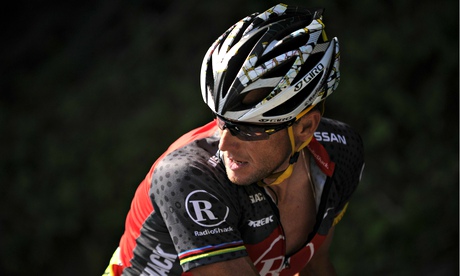
Not long ago, the ubiquitous, upmarket cycling outfitter Rapha sent a marketing circular commemorating the 10th anniversary of the "tragic" death, by cocaine poisoning, of Marco Pantani. The Italian cyclist, the email read, was "a sporting genius… audacious… an iconoclast". He was also, the message didn't read, a career-long doper, a bully and a cheat. Soon you'll be able to buy a special-edition Pantani jersey from Rapha for 100-odd quid and, judging from the 700 likes on Facebook, a queue is already forming.
On the roads, you'd never catch a Mamil wearing the colours of the US Postal Service, the team most associated with Lance Armstrong. And when was the last time you saw someone's cuff ride up to reveal a yellow Livestrong bracelet? Like Pantani, Armstrong was a career-long doper, a bully and a cheat – and yet, evidently, the former is still revered by many fans, while the latter is a leper to most. Why the discrepancy? Are they ethically so different? Well, the refrain typically goes, Armstrong was manipulative, sanctimonious, and he lied and he lied and he lied.
In Cycle of Lies, Juliet Macur sets out to untangle Armstrong's lifetime of dishonesty. This is no small endeavour: few modern figures have worked so hard to shape their own narrative and covered tracks so assiduously. As one of Armstrong's friends said to him after last year's wholly unsatisfactory confession on Oprah: "You are a really good liar, but you are horrible at telling the truth."
Macur, a New York Times journalist, finds some ghoulish new skeletons. Perhaps the most damning witness is John Thomas Neal, a property investor turned masseur who became a surrogate parent to Armstrong in the cyclist's teens. Macur describes Neal as "a man who would come to know Armstrong better than anyone, better than even Armstrong himself". Neal died in 2002, but he left 26 hours of audio recordings that trace the punk kid's ascent to the summit of professional cycling, and Macur is granted exclusive access to the tapes by Neal's family.
The picture of Armstrong that emerges from Neal's testimony is not a flattering one: he starts out a yob and his behaviour only degenerates. When Neal eventually loses his own battle with cancer, Armstrong rocks up at the service wearing flip-flops and informs Neal's daughter: "I don't do funerals." Elsewhere, Macur reveals that Armstrong's upbringing was more privileged, even spoilt, than he has ever acknowledged, while his adoptive father, Terry Armstrong, says: "One thing I'll always say about my son… he's not the brightest tool in the shop."
Macur is a fine writer and a tireless reporter; her coverage of the Tour de France was always essential reading. But, on occasion, Cycle of Lies risks descending into mud-slinging. The success of The Secret Race – the garlanded 2012 autobiography of Tyler Hamilton, Armstrong's team-mate, which covers some of the same ground – was that it rolled along like a thriller but it was also an empathetic and revealing discussion of the moral complexities facing a professional cyclist in an era when drug use was so prevalent. Cycle of Lies reads more as an impassioned, 450-page deposition on why Armstrong is a flawed human being.
There are enough aggrieved cycling fans for this to be a valid line, but this book won't change too many opinions on Armstrong: if you hated him already, you will have plenty more fuel; if you accept, as Armstrong tells Macur, that there are "no good guys and bad guys", it might feel simplistic to lay so many of the problems of a deeply dysfunctional sport at the door of just one athlete.

